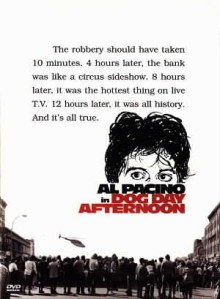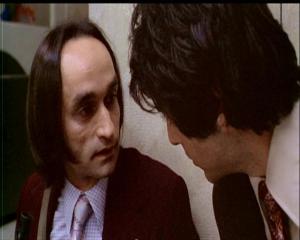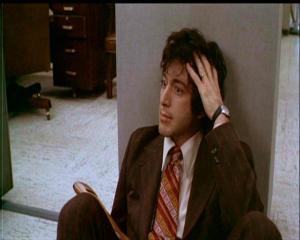The work of Sidney Lumet has become more and more of an obssession for me of late. The latest offering I’ve had the pleasure of looking at is DOG DAY AFTERNOON (1975). This picture, like 12 ANGRY MEN and NETWORK is on the whole, set in one location, but follows a very complex set of circumstances and characters. The story of DOG DAY AFTERNOON is a true one, as the film poster and the title at the begining of the film inform us.
The year is 1972, August 22nd to be precise, the place is Brooklyn, New York. 3 guys walk into a bank with a view to holding the place up and getting out within a few minutes, it didn’t quite work out like that. The incident became a hostage situation covered by national news channels and watched by crowds of baying onlookers. Lumet captures the happening in a raw documentary style, the title sequence is real footage of 70’s New York life. Dirty sidewalks, bums lying sleeping and boats reversing into the Hudson gives the start of the picture a genuine feel that carries on throughout. You can have a look at it below, the music playing is an Elton John track, the first and last time music is heard in the film. no soundtrack, no incidental music. This absence is another powerful tool to heighten the realism of the piece, a realism both praised and criticised by John Wojtowicz, the real life robber, see a piece he wrote regarding the picture here.
Al Pacino plays Sonny Wortzik (Wojtowicz) with John Cazale playing the sidekick who doesn’t chicken out (One guy did a few minutes into the raid) and flee, Sal (Sal Naturale in real life). This is an interesting piece of casting as Naturale was only 18 at the time of the incident whereas Cazale was 40 when the picture was made. Cazale is fantastic here however as the underplayed, understated sidekick. Pacino does all the talking but you always get the feeling that Sal is the one most likely to do real human damage if the situation demands it.
This is only Cazale’s 4th feature and he was only to make one more due to having bone cancer, a disease he worked through on his final feature. No one could have hoped to have achieved more in a 5 picture career. He had notable parts in THE GODFATHER, THE CONVERSATION, THE GODFATHER pt. 2, DOG DAY AFTERNOON and THE DEER HUNTER.
Sal’s journey in this movie is, of course, not the primary concern. The motivations of Sonny are infinately more interesting, as any preconceptions you have are blown out the water in the final 3rd of the movie forcing you to re-examine Sonny as a person. Lumet photographs and stages the various sections of this development wonderfully as the stills below show.
In Sidney Lumet’s book “MAKING MOVIES he says that DDA was one of the most difficult pictures he’d taken on due to a multitude of location problems and hundreds of extras to coordinate. The scene below gives a taster of both the feel of the movie and lends weight to what Lumet is talking about. There is a kinetic quality to the picture despite no one going anywhere. Seeing this movie as an introduction to Lumet will leave you wanting more, I guarantee it.













